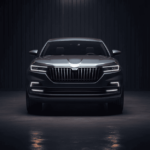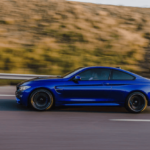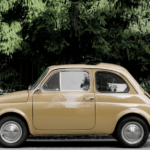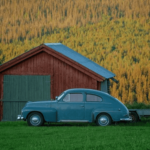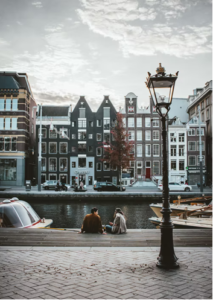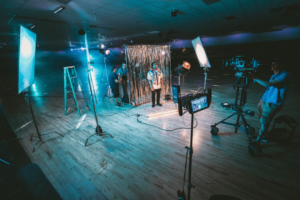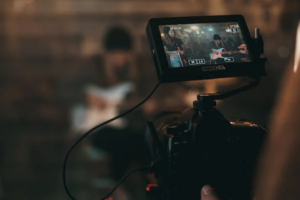Car photography is a specialized field among automotive and photography enthusiasts dedicated to capturing the beauty, design, and performance of automobiles. It combines technical skills, creative composition, and an understanding of lighting to showcase cars in their best light. Car photographers often work to convey the essence of a vehicle, whether it’s a sleek sports car, a vintage classic, or a rugged off-roader. With a focus on angles, reflections, and details, car photography aims to tell a compelling visual story of automotive artistry and engineering prowess. Let’s explore the art of car photography.

What is Car Photography?
Car photography is a specialized genre of photography that focuses on capturing images of automobiles. It involves showcasing the design, aesthetics, details, and often the performance of cars through photographs. Car photographers use various techniques, lighting setups, and camera equipment to create visually appealing images that highlight the unique characteristics of each vehicle. This type of photography is commonly used in automotive advertising, magazines, car reviews, and by car enthusiasts to document and share the beauty and intricacies of automobiles, ranging from sports cars and luxury vehicles to classic cars and off-road vehicles. Car photography often requires an understanding of automotive design and an eye for composition to produce compelling and aesthetically pleasing images.

What is a Car Photographer Called?
A car photographer is often called an “automotive photographer” or “car photographer.” These professionals specialize in capturing the beauty, design, and details of automobiles through their photography. They use their expertise in composition, lighting, and post-processing to create visually stunning images that showcase the unique qualities of each vehicle, whether it’s a high-performance sports car, a classic vintage automobile, or an off-road adventure vehicle. Automotive photographers work closely with car manufacturers, dealerships, and automotive enthusiasts to document and promote cars in a way that highlights their aesthetics and technical features.
How to Become a Car Photographer?
Remember that specialization and a unique style can set you apart in the competitive field of car photography. Developing your signature approach to capturing automobiles can be a valuable asset in your career.
Learn Photography Basics
- Mastering photography fundamentals, including composition, exposure, lighting, and camera operation.
- Understand how to use different camera equipment and lenses effectively.
Get the Right Gear
- Invest in camera equipment suitable for automotive photography, including a DSLR or mirrorless camera, a variety of lenses, and a tripod.
- Consider additional accessories such as external flashes, reflectors, and a polarizing filter to control reflections.
Learn Car Photography Techniques
- Study car photography techniques, such as capturing details, using various angles, and composing shots to highlight the car’s features.
- Understand how to work with natural and artificial lighting to create visually appealing images.
Study Automotive Design
Familiarize yourself with automotive design principles, as a deep understanding of car aesthetics will enhance your photography.
Build a Portfolio
- Begin by photographing your own or friends’ cars to create a portfolio.
- Attend car shows, automotive events, or dealership events to capture a variety of cars and gain experience.
- Collaborate with local car clubs or car owners to arrange photo shoots.
Post-Processing Skills
Learn post-processing techniques using Adobe Photoshop or Lightroom to enhance and retouch your car photos.
Networking
Attend automotive and photography-related events to network with potential clients, car owners, and other professionals in the industry.
Create an Online Presence
- Build a professional website or portfolio showcasing your car photography work.
- Use social media platforms to share your creations, engage with fellow enthusiasts, and connect with potential clients.
Assist Established Photographers
Consider assisting experienced car photographers to gain insights into the industry and learn from their expertise.
Market Your Services
- Promote your car photography services to car dealerships, automotive magazines, car clubs, and private car owners.
- Offer your photography services for automotive events and shows.
Continuous Learning
Stay updated with the latest photography techniques, trends in automotive design, and developments in the automotive industry.
Patience and Persistence
Building a successful career in car photography may take time and effort, so stay persistent and continuously improve your skills.
How to Prepare for an Automotive Photography Shoot?
Preparing for an automotive photography shoot requires careful planning and attention to detail. Here’s how to get ready:
Scout the Location
Visit the shoot location in advance to familiarize yourself with the surroundings, identify potential shooting spots, and consider lighting conditions at different times of the day.
Understand the Car
Learn the car’s make, model, and features. Understanding its design and unique characteristics will help you highlight its best angles.
Check Your Gear
Ensure all your camera equipment is clean, functioning correctly, and fully charged. Bring along a range of lenses to capture various viewpoints and angles.
Pack Essentials

Include accessories like tripods, reflectors, and external flashes for flexibility in your shots.
Weather Forecast
Check the weather forecast and plan accordingly. Different weather conditions can create unique photo opportunities, so be prepared for unexpected changes.
Pre-Visualize Shots
Have a clear vision of the shots you want to capture, considering angles, compositions, and lighting techniques that will enhance the car’s appearance.
Permits and Permissions
If you’re shooting on private property or a controlled location, ensure you have the necessary permits and permissions.
Collaborate
If working with a car owner or a team, communicate your vision and ideas to ensure everyone is on the same page.
Safety First
Be cautious around the car and use proper techniques when working with it to avoid any damage or accidents.
Backup Equipment
Carry backup camera gear, memory cards, and batteries to avoid disruptions due to technical issues.
Timeline

Plan the shoot around the optimal lighting conditions, such as golden hour (early morning or late afternoon), for the best results.
Capture a Variety
Aim to capture various shots, including close-ups of details, wide-angle shots, and dynamic action shots if applicable.
Post-Processing Plan
Consider your post-processing approach and the style you want to achieve in editing.
Test Shots
Before the shoot, take some test shots to fine-tune your camera settings and lighting.
Stay Versatile
Be ready to adjust to shifting circumstances and stay receptive to creative possibilities that might emerge throughout the photo session.
By thoroughly preparing for an automotive photography shoot, you’ll increase your chances of capturing stunning and memorable images of the car that showcase its unique qualities.
How to Position a Car for Photos?
Positioning a car for photos effectively involves selecting a suitable location with a complementary backdrop. Park the car at a 3/4 angle to showcase both the front and side. Pay attention to the background to avoid distractions. Ensure the car is balanced within the frame, avoiding awkward cropping. Experiment with angles and perspectives to find the most flattering view highlighting the car’s features.

Gears Required For Car Photography
Car photography often requires a specific set of gear to capture the beauty and details of automobiles effectively. Here’s a list of essential equipment for car photography:
Camera
A DSLR or mirrorless camera with manual settings empowers you to take charge of exposure and composition.
Lenses
Different lenses offer various perspectives. Consider wide-angle lenses (e.g., 16-35mm) for sweeping shots and prime lenses (e.g., 50mm) for close-ups and details.
Tripod
A sturdy tripod helps stabilize your camera for long exposures and precise compositions, especially in low light.
Remote Shutter Release
This minimizes camera shake when capturing photos without physically touching the camera.
Circular Polarizer Filter
Reduces glare and reflections on the car’s surface and enhances color saturation.
Reflectors
Use reflectors to bounce light onto the car, filling in shadows and adding highlights.
External Flash
For controlling and enhancing lighting, especially in challenging conditions or when shooting interiors.
Lighting Equipment
Consider softboxes or diffusers for controlled studio lighting setups, useful for showcasing specific car features.
Cleaning Kit
Keep the car and camera equipment clean with microfiber cloths, lens cleaning solutions, and a blower brush.
Light Stands and Clamps
Useful for mounting lighting equipment securely in outdoor or studio settings.
Gaffer’s Tape
Versatile for securing gear, holding props in place, or preventing reflections.
Props and Styling Tools
Accessories like cleaning products, microfiber cloths, and props can enhance the car’s appearance and add context to the shots.
Backgrounds
In studio settings, backdrops or seamless paper can create a clean and controlled environment.
Weather Protection
If shooting outdoors, consider rain covers for your camera and equipment in case of unexpected weather changes.
Camera Bag
A well-organized camera bag keeps your gear protected and accessible during the shoot.
Car Mounts
For action shots or shots from moving vehicles, car mounts provide secure camera placement.
Laptop and Editing Software
Review and edit your photos on-site or during post-processing.
Smartphone or Tablet
Useful for controlling cameras remotely, checking angles, or using photography apps.
Tire Shine and Detailing Products
To enhance the appearance of tires and car surfaces.
Safety Gear
If working in risky conditions, such as on a race track, ensure you have the necessary safety gear, like a helmet and high-visibility vest.
The specific gear you need can vary depending on the type of car photography you’re doing, whether outdoor, studio, action or detail-oriented shots. Always tailor your equipment to the unique requirements of each shoot.
Car Photography Angles
Car photography offers a range of creative possibilities, and choosing the right angles can significantly impact the final result. Here are some common car photography angles to consider:
Front View
Capture the car’s front end head-on. This angle showcases the car’s grille, headlights, and overall face, highlighting its character and design.
Side View
Position the camera perpendicular to the car’s side to emphasize its profile. This angle showcases the car’s overall shape, lines, and silhouette.
Rear View

Similar to the front view, but focusing on the rear end of the car. This angle highlights the car’s tail lights, exhaust, and rear design features.
3/4 View
Angle the camera slightly in front or behind the car, capturing about three-quarters of the vehicle. This angle provides depth and shows both the front and side of the car, creating a dynamic composition.
Low Angle
Shoot from a lower perspective, close to the ground. This angle emphasizes the car’s presence and can make it appear more imposing.
High Angle

Position the camera above the car to capture a bird’s-eye view. This angle is useful for showcasing the car’s entire shape and surroundings.
Worm’s-Eye View
Get down low, close to the ground, and shoot upward. This angle can make the car look powerful and larger than life.
Interior Shots
Capture the car’s interior, focusing on the dashboard, steering wheel, and seating. Use natural or interior lighting to enhance details.
Detail Shots

Zoom in on details like the logo, wheels, exhaust pipes, or other unique features. This angle highlights the car’s craftsmanship and design intricacies.
Action Shots
Photograph the car in motion to convey a sense of speed and excitement. This can be achieved through panning techniques or car mounts for dynamic action shots.
Close-Up

Get close to the car’s surface to highlight textures, reflections, and details. This angle is excellent for abstract or artistic shots.
Environment Shots
Include the car in its natural environment, such as a scenic landscape, urban setting, or relevant backdrop. This angle adds context and tells a story.
Reflection Shots
Use reflections on car surfaces, like hoods or side panels, to create unique and abstract compositions.
Undercarriage

Capture the car from underneath to showcase the chassis, suspension, and exhaust system. This angle is ideal for automotive enthusiasts interested in technical details.
Experimenting with different angles and perspectives allows you to create diverse and captivating car photography. Consider the car’s design, purpose, and the story you want to convey when selecting the most suitable angle for your shots.
How Do Car Photographers Make Money?
Car photographers generate income through various avenues. They often work with automotive publications, shooting vehicles for editorial features and reviews. Commercial clients, such as car manufacturers and dealerships, hire them for marketing materials, brochures, and advertisements. Many car photographers establish themselves as freelancers, offering their services to private car owners and enthusiasts who desire professional photos of their vehicles. They can also sell their automotive images as stock photos on platforms like Shutterstock. Additionally, some photographers teach workshops or offer photography-related products. Diversifying their income sources and building a strong portfolio are key to their success in the industry.
How Do I Become A Commercial Car Photography?
To become a commercial car photographer:
- Start by honing your photography skills and acquiring the necessary equipment, including a DSLR or mirrorless camera and a range of lenses.
- Build a strong portfolio showcasing your ability to capture cars compellingly and professionally.
- Network with automotive industry professionals, including car manufacturers, dealerships, and advertising agencies, to establish connections and secure commercial assignments.
- Offer your services for car marketing campaigns, brochures, and advertisements.
- Develop expertise in post-processing using software like Adobe Lightroom and Photoshop.
Consistency, a strong portfolio, and industry connections are key to a successful career as a commercial car photographer.
Pro Tips for Car Photography
To elevate your car photography and capture stunning shots, consider these pro tips:
Choose the Perfect Time and Location

Plan your photography session during the golden hour, which takes place in the early morning or late afternoon, to take advantage of soft, warm lighting. Select a setting that complements the car’s style and intended purpose, whether it’s an urban backdrop, a scenic route, or a studio environment.
Clean and Prep the Car
Ensure the car is spotlessly clean, both inside and out. Pay attention to details like tires, windows, and the engine bay. Remove any distractions or clutter from the interior.
Use a Tripod
A tripod provides stability for precise compositions and long exposures. It’s especially useful for interior and detail shots.
Compose Thoughtfully

Pay attention to composition rules like the rule of thirds and leading lines. Experiment with various angles, including low, high, and 3/4 views, to find the most flattering perspectives.
Control Reflections
Minimize unwanted reflections on the car’s surface using a circular polarizer filter or adjusting your shooting angle. Reflectors can also help bounce light onto the car to fill in shadows.
Master Lighting
Understand the role of natural and artificial lighting. Try various lighting arrangements, such as softboxes and diffusers, to regulate and improve the lighting in a studio environment.
Bracketing and HDR

Use bracketing to capture multiple exposures and create HDR (High Dynamic Range) images, which preserve details in both highlights and shadows.
Depth of Field
Adjust your aperture to control the depth of field. A wide aperture (e.g., f/2.8) can create a blurred background (bokeh) to isolate the car, while a narrow aperture (e.g., f/11) keeps more in focus.
Framing and Leading Lines
Frame the car within the surrounding environment to create context and depth. Utilize leading lines like roads or architectural elements to guide the viewer’s eye.
Detail Shots
Capture close-up shots of specific features, such as the emblem, wheels, or interior details, to highlight craftsmanship and design intricacies.
Experiment with Shutter Speed

Experiment with various shutter speeds to capture different effects. Slow shutter speeds can convey motion, while fast speeds freeze action.
Post-Processing
Use post-processing software like Adobe Lightroom or Photoshop to enhance colors, contrast, and sharpness. Be mindful of not over-processing, as subtlety often yields the best results.
Safety First
If capturing action shots or shooting on a road, prioritize safety. Ensure the driver and photographer know safety measures and precautions.
Collaborate

If working with a model or driver, communicate your vision and work collaboratively to achieve the desired shots.
Continuous Learning
Stay updated with photography techniques, editing software, and trends in automotive design to keep refining your skills.
Videos
10 Car Photography Tips! (How to Start for beginners!)
SECRETS to Shooting CAR PHOTOGRAPHY Like a PRO – You gotta see these results!
How to shoot CARS! 5 tips to better Automotive Photography!
10 Automotive Photography Tips — Lenses, Angles, Light Mixing & More!
